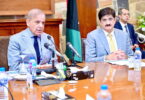F.P. Report
ISLAMABAD: Minister for Defense Production Zubaida Jalal Khan Monday said that socio-economic development linked with the girls’ education and government was committed to provide education to women.
Addressing the Report Launching ceremony of ASER Survey 2019, she said that education was major defense and gate-way to the socio-economic development of the country.
The ceremony was also attended by Minister for education Gilgit-Baltistan (GB) Muhammad Ibrahim Sanai, Chief Executive Officer – Idara-e-Taleem-o-Aagahi (ITA) Baela Jamil, MNA Mehnaz Akbar Aziz, Chairman National Commission for Human Development and others.
Speaking on the occasion, she said that education was the basic right of every citizen under the Article 25 A of the constitutions.
Commenting on the issues raised in the ASER report especially in the rural areas like missing facilities at schools, lack of transportation for girls, wash rooms at schools and enrollment in schools, she said that the government would resolve these challenges on priority.
She underlined the need of using modern technology for the promotion of education by the government and concerned departments to achieve the 100 percent literacy rate.
The government has endorsed and was committed to meeting the SDGs by 2030 to end poverty with an educationally entitled society as elaborated in SDG 4 goal, its seven targets and three means of implementation.
The provinces have aligned their sector plans to SDG 4 (12 years of schooling) and Article 25 A, she added.
Minister for Education GB, Muhammad Ibrahim said that consistent efforts, hard work and commitment were needed to achieve the task.
He said that GB government had done a lot for girls’ education adding “We have ensured provision of books and uniform in the GB schools”.
He said that technology was effective tools for promoting education.
According to the survey, trends in learning levels in language and arithmetic from 2014 to 2019 show an improvement from 13 to 17 percent for grade 5; however, children continue to struggle in grade 3 due to low grasp of foundational skills in basic literacy and numeracy.
Despite the recent focus of the federal and provincial governments on enrolment drives to honor Article 25 A, 17 percent children aged 6-16 still remain out of school, according to the Annual Status of Education Report (ASER) 2019 National (rural) survey launched on Monday.
In contrast, the survey revealed that in 20 urban centers across Pakistan, only 6% children were out of school.
With 40% of the population residing in urban areas, this presents an important opportunity to accelerate universal access for the urban 5-16 year olds, whilst simultaneously focusing on rural areas.
Education targets can be met through extra ordinary resolve and actions by the state to guarantee a constitutional fundamental right.
AJK, GB and Punjab have recorded a slim annual increase in enrolment between1% to 2%. ASER rural results over the years highlight a decline in the number of children going to private sector schools; 23% children of age 6-16 were enrolled in private sector in 2019 compared to 30% in 2014.
The shift to government/public sector schools has increased the enrolment share from 70 % (2014) to 77% in 2019. This edge must be maintained with persistent state actions for quality facilities.
According to the rural report, student competencies in learning Language, English, and Arithmetic have improved 59% of the children from Class V read Class II level story text in Urdu/Sindhi/Pashto; in English. Arithmetic learning levels have also improved since 2018; now 57% of class V children could do a two-digit division, pegged at second grade curriculum. New questions on time recognition along with word problems on addition and multiplication were also added for the first time. 60% of children in class 5 could recognize time correctly, 60% could solve addition word problem and 53% could solve multiplication word problem.
Private sector schools report better learning outcomes and boys outperform girls. In comparison, the learning levels in urban areas are considerably higher than rural areas across all three competencies.
Overall, 70% of the children enrolled in grade 5 in all urban districts can read a story in the local language, 67% can read sentences in English while 66% can do division with reduced gender gaps.
The ASER report highlights school functioning across every district in Pakistan. Teachers’ attendance in government and private schools stood same at 89% closing the gap, on the day of the survey. Whilst private school teachers were reported to have better qualifications at graduate levels (40%) compared to 33% in improvement schools; however, for MA/MSC qualifications, a larger percentage of public sector teachers have a higher qualification than private counterparts.






